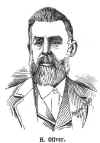bank in a frenzy of excitement, exclaiming: "Come, Sol, come!
'ell's to pay! Judge Gibbon is hat my 'ouse in a fit: we 'ave to tie 'im.''
Without waiting for Sol's question Oliver ran back Solly after him believing that the 250 lbs. Judge Gibbon, if in a fit would be a bad man.
Solly entered the dugout like a drowned rat paralyzed on beholding the smiling Squire Oliver standing beside Widow Hope in the center of the floor with the Probate Court before them, a session-law pamphlet in his legal hand, about to join them husband and wife.
That he did then and there. This was the second marriage that occurred in Norton county.
 Henry Oliver was born November 14, 1831 at West Hyde, Hertfordshire, England; in 1851 emigrated to America and arrived in New York after a voyage of six weeks and located at Gilbertsville, Otsego county, New York; in 1832 moved to Ohio and located at Painsville, Lake county; moved back to New York in 1853 and located at Morris, Otsego county and there served three years as apprentice to a carriage maker; worked at his trade until September 26, 1861, at which time he was enrolled in company C New York Morgan's flying artillery; was discharged from the United States Service on November 5, 1863 at Fort Bennett, Virginia; re-enlisted on the 7th day of November and fought like a Trojan in the following battles: Bull Run, Spottsylvania, North Hanna, Tolopotomy, Cold Harbour, Petersburg, Jerusalem Plank Road, Deep Bottom, Hatche's Run, battle of 2nd corps, Five Forks, South Side R. R. Evacuation of Petersburg, Sailor Creek, Farmville or Round Fort, Surrender of Lee's army at Appomattox.
After the surrender of Lee's army he returned to Washington and took part in the grand review, and on September 29, was discharged at Washington, D.C.; he then returned to New York and again went to work at the carriage business.
Henry Oliver was born November 14, 1831 at West Hyde, Hertfordshire, England; in 1851 emigrated to America and arrived in New York after a voyage of six weeks and located at Gilbertsville, Otsego county, New York; in 1832 moved to Ohio and located at Painsville, Lake county; moved back to New York in 1853 and located at Morris, Otsego county and there served three years as apprentice to a carriage maker; worked at his trade until September 26, 1861, at which time he was enrolled in company C New York Morgan's flying artillery; was discharged from the United States Service on November 5, 1863 at Fort Bennett, Virginia; re-enlisted on the 7th day of November and fought like a Trojan in the following battles: Bull Run, Spottsylvania, North Hanna, Tolopotomy, Cold Harbour, Petersburg, Jerusalem Plank Road, Deep Bottom, Hatche's Run, battle of 2nd corps, Five Forks, South Side R. R. Evacuation of Petersburg, Sailor Creek, Farmville or Round Fort, Surrender of Lee's army at Appomattox.
After the surrender of Lee's army he returned to Washington and took part in the grand review, and on September 29, was discharged at Washington, D.C.; he then returned to New York and again went to work at the carriage business.
Henry Oliver bought the lots where Kahn's and Shimeall's stores now stand for $10 and in 1873 built the first wagon shop there, a good frame building now used as a dwelling house near the fair ground.
He operated this shop for five years, using it also as a court room in his justice practice.
Mary A. Williams was born May 21, 1839; she was married to John E. Davis January 1, 1860.
He was born in Morgan county, Ohio, December 8, 1831; moved to Vernon county, Wisconsin in 1855.
He volunteered in company A. 26th Wisconsin infantry August 14, 1863; was made commissary sergeant; was in the sieges of Vicksburg and Atlanta and marched with Sherman to the sea; he was mustered out at Madison, Wisconsin.
He moved to Brown county, Kans., in 1869; came to Norton county in May 1885; he was trustee of Center township in 1890; was elected on city council in 1891, and 1893: he is now engaged in the coal and grain business.
They have two sons, Ellsworth J. and Nona A., who came here with their father in 1885, and went into the hardware business.
They sold out in 1889 and went to Milton, Oregon and are now engaged in banking.
They are both graduates of the Quincy Business college, at Quincy Ill. E J. was born September 26, 1862; he was married to Laura M. Reno May 15, 1887; they have two children.
E. J. was a member of the city council for two years and master of the Masonic lodge for one year while in Norton.
Nona Austin was born February 15,1867; was married at Santiego, California, to Maude
McCrea, they have one child.
Almyra Williams was born November 19, 1847; she married Henry Anderson July 28, 1868.
He was a soldier in the 49th Iowa Infantry, was also a minister in the Christian church.
He died of consumption
|